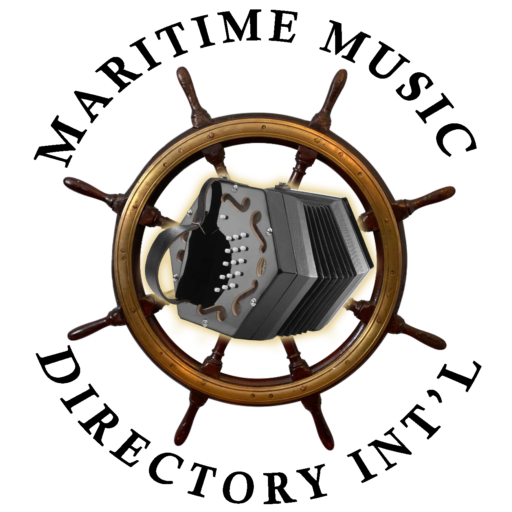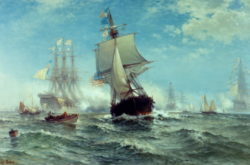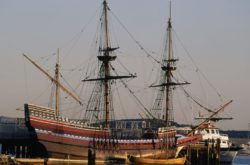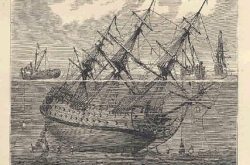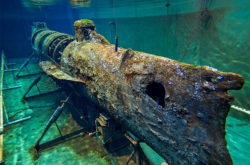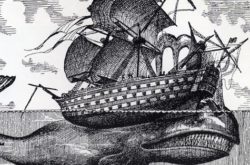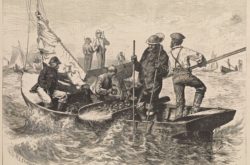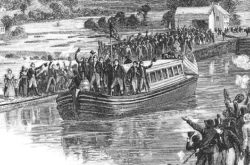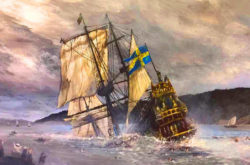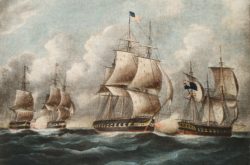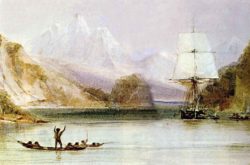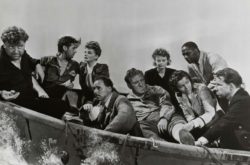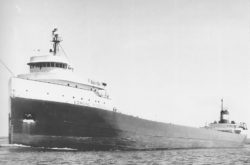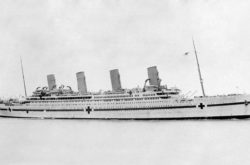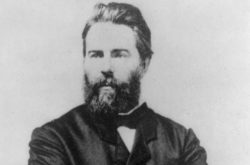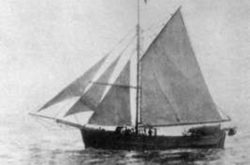John Paul Jones Sails to Raid British Ships (1777)
On November 2, 1777, the USS Ranger, with a crew of 140 men under the command of John Paul Jones, leaves Portsmouth, New Hampshire, for the naval port at Brest, France, where it will stop before heading toward the Irish Sea to begin raids on British warships. This was the first mission of its kind during the Revolutionary War. Read the complete article on History.com.
Mayflower docks at Plymouth Harbor (1620)
On December 18, 1620, the British ship Mayflower docked at modern-day Plymouth, Massachusetts, and its passengers prepared to begin their new settlement, Plymouth Colony. The famous Mayflower story began in 1606, when a group of reform-minded Puritans in Nottinghamshire, England, founded their own church, separate from the state-sanctioned Church of England. Accused of treason, they were forced to leave the country and settle in the more tolerant Netherlands. After 12 years of struggling to adapt and make a decent living, the group sought financial backing from some London merchants to set up a colony in America. On September 6, 1620, 102 passengers–dubbed Pilgrims by William Bradford, a passenger who would become the first governor of Plymouth Colony–crowded on the Mayflower to begin the long, hard journey to a new life in the New World. Read the complete article on History.com.
Royal George Sinks During Refitting (August 29, 1782)
Royal George sank on 29 August 1782 whilst anchored at Spithead off Portsmouth. The ship was intentionally rolled so maintenance could be performed on the hull, but the roll became unstable and out of control; the ship took on water and sank. More than 800 lives were lost, making it one of the most deadly maritime disasters in British territorial waters. Several attempts were made to raise the vessel, both for salvage and because she was a major hazard to navigation in the Solent. In 1782, Charles Spalding recovered fifteen 12-pounder guns using a diving bell of his own design. From 1834 to 1836, Charles and John Deane recovered more guns using a diving helmet they had invented. In 1839 Charles Pasley of the Royal Engineers commenced operations to break up the wreck using barrels of gunpowder. Pasley’s team recovered more guns and other items between 1839 and 1842. In 1840, they destroyed the remaining structure of the wreck in an explosion which shattered windows several miles away in Portsmouth and Gosport. Link to full article on Wikipedia.
H.L. Hunley sinks during tests (15 Oct 1863)
On October 15, 1863, the H.L. Hunley, the world’s first successful combat submarine, sinks during a test run, killing its inventor and seven crew members. Horace Lawson Hunley developed the 40-foot submarine from a cylinder boiler. It was operated by a crew of eight—one person steered while the other seven turned a crank that drove the ship’s propeller. The Hunley could dive, but it required calm seas for safe operations. It was tested successfully in Alabama’s Mobile Bay in the summer of 1863, and Confederate commander General Pierre G.T. Beauregard recognized that the vessel might be useful to ram Union ships and break the blockade of Charleston Harbor. The Hunley was placed on a railcar and shipped to South Carolina. Read the full article on History.com.
Mary Rose Sinks
Mary Rose Sinks (1545) Several theories are thought to explain how and why Henry VIII’s flag ship sunk at the Battle of Solent. Recovered in 1982 and is now on display in Portsmouth, UK. Mary Rose was one of the largest ships in the English navy through more than three decades of intermittent war, and she was one of the earliest examples of a purpose-built sailing warship. She was armed with new types of heavy guns that could fire through the recently invented gun-ports. She was substantially rebuilt in 1536 and was also one of the earliest ships that could fire a broadside, although the line of battle tactics had not yet been developed. Several theories have sought to explain the demise of the Mary Rose, based on historical records, knowledge of 16th-century shipbuilding, and modern experiments. The precise cause of her sinking is subject to conflicting testimonies and a lack of conclusive evidence. Link to full article on Wikipedia.
Whaleship Essex Sunk by Sperm Whale
The American whaler Essex, which hailed from Nantucket, Massachusetts, is attacked by an 80-ton sperm whale 2,000 miles from the western coast of South America. The 238-ton Essex was in pursuit of sperm whales, specifically the precious oil and bone that could be derived from them, when an enraged bull whale rammed the ship twice and capsized the vessel. The 20 crew members escaped in three open boats, but only five of the men survived the harrowing 83-day journey to the coastal waters of South America, where they were picked up by other ships. Most of the crew resorted to cannibalism during the long journey, and at one point men on one of the long boats drew straws to determine which of the men would be shot in order to provide sustenance for the others. Three other men who had been left on a desolate Pacific island were saved later. The first capture of a sperm whale by an American vessel was in 1711, marking the birth of an important American industry that commanded a fleet of more than 700 ships by the mid 18th century. Herman Melville’s classic novel Moby Dick (1851) was inspired in part by the story of the Essex. Read the Complete article on History.com.
Thomas Downing was a fine-dining pioneer with a secret
Thomas Downing was a fine-dining pioneer with a secret.
Erie Canal Opens (1825)
The Erie Canal opens, connecting the Great Lakes with the Atlantic Ocean via the Hudson River. Governor DeWitt Clinton of New York, the driving force behind the project, led the opening ceremonies and rode the canal boat Seneca Chief from Buffalo to New York City. Work began on the waterway in August 1823. Teams of oxen plowed the ground, but for the most part the work was done by Irish diggers who had to rely on primitive tools. They were paid $10 a month, and barrels of whisky were placed along the canal route as encouragement. West of Troy, 83 canal locks were built to accommodate the 500-foot rise in elevation. After more than two years of digging, the 425-mile Erie Canal was opened on October 26, 1825, by Governor Clinton. The effect of the canal was immediate and dramatic. Settlers poured into western New York, Ohio, Michigan, Illinois, and Wisconsin. Goods were transported at one-tenth the previous fee in less than half the time. Barges of farm produce and raw materials traveled east, as manufactured goods and supplies flowed west. In nine years, tolls had paid back the cost of construction. Later enlarged and deepened, the canal survived competition from the railroads in the latter part of the 19th century. Today, the Erie Canal is used mostly by pleasure boaters, but it is still capable of accommodating heavy barges. Read the entire article on History.com.
Vasa departs Stockholm and Sinks (1628)
Vasa is a Swedish warship built between 1626 and 1628. The ship sank after sailing roughly 1,300 m (1,400 yd) into her maiden voyage on 10 August 1628. She fell into obscurity after most of her valuable bronze cannon were salvaged in the 17th century, until she was located again in the late 1950s in a busy shipping area in Stockholm harbor. The ship was salvaged with a largely intact hull in 1961. She was housed in a temporary museum called Wasavarvet (“The Vasa Shipyard”) until 1988 and then moved permanently to the Vasa Museum in the Royal National City Park in Stockholm. The ship is one of Sweden’s most popular tourist attractions and has been seen by over 35 million visitors since 1961. Since her recovery, Vasa has become a widely recognized symbol of the Swedish Empire. Link to full article on Wikipedia.
Battle of Lake Erie (Sept. 10, 1813)
In the first unqualified defeat of a British naval squadron in history, U.S. Captain Oliver Hazard Perry leads a fleet of nine American ships to victory over a squadron of six British warships at the Battle of Lake Erie during the War of 1812. The battle was closely contested for hours, and Perry’s flagship Lawrence was reduced to a defenseless wreck. He then transferred to the Niagara and sailed directly into the British line, firing broadsides and forcing the British to surrender. Perry had won a complete victory at the cost of 27 Americans killed and 96 wounded; British casualties were 40 dead and 94 wounded. After the battle, Perry sent a famous dispatch to U.S. General William Henry Harrison that read, “We have met the enemy, and they are ours.” The Battle of Lake Erie forced the British to abandon Detroit, ensuring U.S. control over Lake Erie and the territorial northwest.Read the full article on History.com
Defeat Armada 1588
England Defeats Spanish Armada (1588) On July 29, 1588 England defeats the Spanish Armada Off the coast of Gravelines, France, Spain’s so-called “Invincible Armada” is defeated by an English naval force under the command of Lord Charles Howard and Sir Francis Drake. After eight hours of furious fighting, a change in wind direction prompted the Spanish to break off from the battle and retreat toward the North Sea. Its hopes of invasion crushed, the remnants of the Spanish Armada began a long and difficult journey back to Spain. Link to full article on History.com.
Darwin Returns to Falmouth 2 Oct 1831
The British naturalist Charles Darwin returns to Falmouth, England, aboard the HMS Beagle, ending a five-year surveying expedition of the southern Atlantic and Pacific oceans. Visiting such diverse places as Brazil, the Galapagos Islands, and New Zealand, Darwin acquired an intimate knowledge of the flora, fauna, and geology of many lands. This information proved invaluable in the development of his theory of evolution, first put forth in his groundbreaking scientific work of 1859, The Origin of Species by Means of Natural Selection. Darwin’s theory argued that organisms gradually evolve through a process he called “natural selection.” In natural selection, organisms with genetic variations that suit their environment tend to propagate more descendants than organisms of the same species that lack the variation, thus influencing the overall genetic makeup of the species. His Origin of Species, the first significant work on the theory of evolution, was greeted with great interest in the scientific world but was attacked by religious leaders for its contradiction of the biblical account of creation. Read a complete article on National Geographic’s website: https://education.nationalgeographic.org/resource/hms-beagle-darwins-trip-around-world
Hollywood and the Sea:
Maritime History & Culture in Film
Register Here for the Zoom Seminar Saturday, 5 November 2022Welcome & Lecture at 11:00 AM ET, Q&A to Follow Seminars are free to attend, although we hope you will support the Series with a suggested $10 Seminar Guest donation. You won’t want to miss this special seminar with SUNY Maritime Professor Dr. John Rocco for an overview of one of his most popular courses, Hollywood and the Sea: Maritime Culture and Film. The seminar will explore Hollywood’s depiction of the maritime realms of war, work, law, and discovery, examining important themes and subjects raised by the films—the voyage narrative, American whaling, famous naval battles, slavery, World War II, and maritime crime and punishment. Dr. Rocco will guide us through the history of maritime Hollywood through the work of directors such as Buster Keaton, Michael Curtiz, Alfred Hitchcock, Howard Hawks, John Ford, Elia Kazan, Edward Dmytryk, John Huston, Francis Ford Coppola, and Steven Spielberg. For an early look at some of the films Dr. Rocco highlights in his course, see Steamboat Bill, Jr. (1928), Down to the Sea in Ships (1922), Mutiny on the Bounty (1935 and 1962), Two Years Before the Mast (1946), Moby Dick (1930 and 1956), Captain Blood (1935), The Long Voyage Home (1940), Mister Roberts (1955), The Battle of Midway (1942), They Were Expendable (1945), Action in the North Atlantic (1943), The African Queen (1951), The Caine Mutiny (1954), On the Waterfront (1954), To Have and Have Not (1944), The Breaking Point (1950), Jaws (1975), Amistad (1997), and Apocalypse Now (1979). About the SpeakerIn addition to being a well-loved professor of composition, literature, film, and other graduate studies, Dr. Rocco is also an author and the coordinator of the Maritime and Naval Studies (MNST) master’s program at SUNY Maritime. He has long been involved with digitizing years of records from Sailors’ Snug Harbor and received the SUNY Chancellor’s Award for Excellence in Teaching.
Mutiny on the Amistad
Mutiny on the Amistad slave ship (July 2, 1839) Early in the morning of July 2, 1839, Africans on the Cuban schooner Amistad rise up against their captors, killing two crewmembers and seizing control of the ship, which had been transporting them to a life of slavery on a sugar plantation at Puerto Principe, Cuba. Link to full article on History.com
Cargo ship suddenly sinks in Lake Superior (1975)
On November 10, 1975, the SS Edmund Fitzgerald sinks in Lake Superior, killing all 29 crew members on board. It was the worst single accident in Lake Superior’s history. The ship weighed more than 13,000 tons and was 730 feet long. It was launched in 1958 as the biggest carrier in the Great Lakes and became the first ship to carry more than a million tons of iron ore through the Soo Locks. Read the complete article on History.com.
Britannic, sister ship to the Titanic, sinks in Aegean Sea
The Britannic, sister ship to the Titanic, sinks in the Aegean Sea on November 21, 1916, killing 30 people. More than 1,000 others were rescued. In the wake of the Titanic disaster on April 14, 1912, the White Star Line made several modifications in the construction of its already-planned sister ship. First, the name was changed from Gigantic to Britannic (probably because it seemed more humble) and the design of the hull was altered to make it less vulnerable to icebergs. In addition, it was mandated that there be enough lifeboats on board to accommodate all passengers, which had not been the case with the Titanic. Read the complete article on History.com.
Herman Melville sails for the South Seas (1841)
On January 3, 1841, Herman Melville ships out on the whaler Acushnet to the South Seas. Melville was born in New York City in 1819. A childhood bout of scarlet fever permanently weakened his eyesight. He went to sea at age 19, as a cabin boy on a ship bound for Liverpool. Two years later, he sailed for the South Seas. The Acushnet anchored in Polynesia, where Melville took part in a mutiny. He was thrown in jail in Tahiti, escaped, and wandered around the South Sea islands for two years. In 1846, he published his first novel, Typee, based on his Polynesian adventures. His second book, Omoo (1847), also dealt with the region. The two novels were popular successes, although his third, Mardi Moby-Dick. The book flopped and was not recognized as a classic for many years. Click here to read the complete article on History.com.
Zong Slave Ship Trial
Zong slave ship trial June 22, 1783 London: Hearing arguments in the case of the Zong, a slave ship, the Chief Justice of the King’s Bench in London states that a massacre of enslaved African “was the same as if Horses had been thrown over board” on June 22, 1783. The crew of the Zong had thrown at least 142 captive Africans into the sea, but the question before the court was not who had committed this atrocity but rather whether the lost “cargo” was covered by insurance. The trial laid bare the horror and inhumanity of the Atlantic slave trade and galvanized the nascent movement to abolish it. Link to full article on History.com
Roald Amundsen becomes first explorer to reach the South Pole
On December 14, 1911, Norwegian Roald Amundsen becomes the first explorer to reach the South Pole, beating his British rival, Robert Falcon Scott. Amundsen, born in Borge, near Oslo, in 1872, was one of the great figures in polar exploration. In 1897, he was first mate on a Belgian expedition that was the first ever to winter in the Antarctic. In 1903, he guided the 47-ton sloop Gjöa through the Northwest Passage and around the Canadian coast, the first navigator to accomplish the treacherous journey. Amundsen planned to be the first man to the North Pole, and he was about to embark in 1909 when he learned that the American Robert Peary had achieved the feat. Click here to read the complete article on History.com.
Frobisher
Sir Martin Frobisher The advance of science appeared more dramatically in the efforts of adventurous or acquisitive spirits to explore the “great Magnet” (North America) for geographical or commercial purposes. In 1576 Sir Humphrey Gilbert published a suggestive Discourse… for a New Passage to Cataia – i.e., “Cathay,” or China – proposing a northwest sailing through or around Canada. Sir Martin Frobisher, in that year, set out with three small vessels to find such a route. One of his ships foundered, another deserted; he went ahead in the tiny twenty-five-ton Gabriel; he reached Baffin Land, but the Eskimos fought him, and he returned to England for more men and supplies. His later voyages were diverted from geography by a vain hunt for gold. Gilbert took up the quest for a northwest passage, but was drowned in the attempt (1592). The Age of Reason Begins, Will and Ariel Durant. It is commonly taught that the English ships were smaller than the Spanish. This is a misconception caused by the practice of Spanish captains to inflate the size of their ships in order to get more compensation for their use in war. At the beginning of the 16th century the English ton was equal to the Spanish tonelada, but by the time of the Armada the tonelada had shrunken to 1/2 ton. In addition, the largest ship in the battle was the 1,100 ton Triumph under the command of Frobisher. The Cavalier Compendium, Mark & Jennie Gist The English explorer Martin Frobisher created a gold fever in England in 1578 when he returned from Baffin Island with 200 tons of glittering gold ore. Great preparations were made for getting more and more gold, but it turned out that the ore was merely iron pyrite (“fool’s gold”). It was eventually crushed and used for road repair. Isaac Asimov’s Book of Facts Elizabethan Mariners
